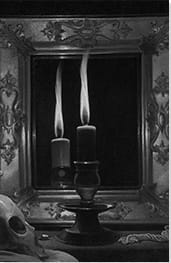Summary of Georges de La Tour
One of the greatest exponents of 17th century Baroque painting, La Tour's mastery of chiaroscuro was such that he is often named as Caravaggio's natural successor. But La Tour's paintings, although relatively small in number, stand on their own terms for an economy of styling that charge his brooding candlelit scenes with a sense of enigmatic tranquility. La Tour's oeuvre shows a steady progression towards a uniquely minimalist style that would touch upon elements of symmetrical abstraction. Indeed, several historians have championed la Tour as the true progenitor of the Cubist movement. Although he was much admired in his own day, La Tour joins the exalted company of Piero della Francesca and Vermeer as canonical artists whose names and works had fallen into obscurity (and in La Tour's case, misattributed) before being rediscovered (and re-championed) by historians in the 20th century.
Accomplishments
- La Tour's distinguished himself from others working in the Baroque style through a series of works that feature figures lit dramatically by the soft glow of a single light source. La Tour became increasingly drawn to candlelight scenes - often featuring a young boy or girl absorbed in an everyday task, whereby the flame spreads an atmosphere of otherworldly calm across the whole canvas. As his style evolved, La Tour's works would become increasingly sparse, with his masses reduced to simple, almost geometrical, dimensions. This technique imbues his works with a somewhat modern appearance that has provided a significant addition to the catalogue of 17th century French art.
- La Tour is sometimes referred to as a realist on the grounds that his works addressed the lives and experiences of the "common folk" of his hometown of Lorraine. But La Tour was not a naturalist. For his "real-life" works he achieved a sober, but meditative, quality. Indeed, rather than fixate the picturesque style that was prevalent in Northern Europe at the time, La Tour turned to the Caravaggesque realist approach since it provided the best means of representing "the soul of man".
- La Tour's sparsely populated pictures are rendered in "anonymous" locations with the absence of setting or scenery. His subjects never pose in front of architectural backgrounds or landscapes, with borders and boundaries delineated typically through partitioning devices such as walls. He omitted subsidiary figures with incidental accessories kept to the bare minimum (even his saints and angels were without haloes and wings). This technique, which brought a sense of silent calm, contributed to the enigmatic quality that has come to distinguish his work.
- La Tour's paintings, almost exclusively genre and religious works, can be divided between daytime and night-time scenes. Whereas the latter are defined by artificial light and a near elimination of color, the former, such as The Cheat with the Ace of Diamonds (c. 1635) and The Fortune-Teller (undated, c.1630-34), are distinguished by for their sharp, clear lighting, and a precision of brushwork. La Tour's works from this phase already indicate something of his individuality in their exquisite ornamentations and rendering of textures.
The Life of Georges de La Tour
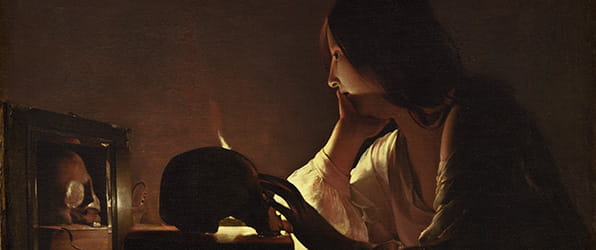
According to author Christopher Wright, La Tour, "was seen as the great master of candlelight paintings, set apart from his contemporaries, by a near magical approach, both in subject matter and technique".
Important Art by Georges de La Tour

The Payment of Taxes
An important early work by La Tour, it shows an elderly man paying a tax (or debt) to group of men. The scene carries an element of threat in that the taxpayer seems as if he is being intimidated by the group. Author Philip Conisbee says of the work, "It has been convincingly suggested that its source lies in the tradition of tax-paying scenes, a well-established theme in Netherlandish art since the sixteenth century". Yet the painting carries a certain ambiguity in that, what might be on surface level a generic peasant scene of the powerful subjugating the meek, could be a modern reinterpretation of the biblical story of the "Calling of Matthew" (the tax collector who became a disciple) if, as some historians believe, it was painted during the earliest period of his career when he was chiefly engaged in painting the saints.
In either case, this work offers confirmation of La Tour's skill at creating complex group compositions. According to Conisbee, here "La Tour employs a crowded space, somewhat awkward, eccentric poses, and a self-conscious use of artificial light to create the atmosphere of a silent and unsettling drama. Every feature of the painting - gestures, expressions, enigmatic poses, the play of light and shade - works to produce a tense, concentrated mood. Even the elevated viewpoint adds to the tension we experience from this encounter. [Even though early in his career, it] is already characteristic of La Tour's approach to painting: he rarely chooses an innovative subject, but he meditates on it deeply and presents it in a highly focused or concentrated way. There is no visual distraction, no ornament for ornament's sake. Forms are reduced to essentials, as are the gestures and expressions of his actors, establishing in this case a threatening mood".
Oil on canvas - Museum of Fine Arts, Lviv, Ukraine
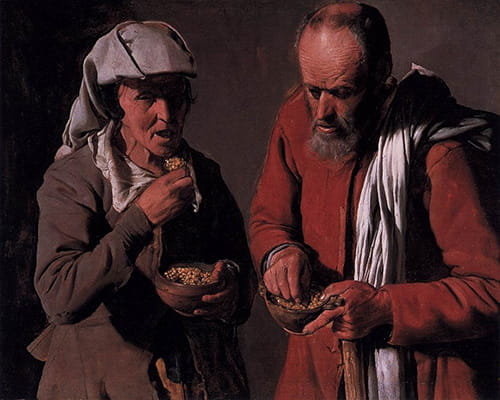
Old Peasant Couple Eating
This painting is one of La Tour's key early works. It amply demonstrates his flair for capturing the mood of his subjects. As author Vittorio Maria de Bonis notes, the couple "ignore each other and instead sink their melancholy gaze into the eyes of the viewer as they angrily and greedily eat spoonfuls of the bright peas inside chipped, rough terracotta bowls". The mature figures are desperately hungry and they might easily symbolize the population of Lorraine (in Northeastern France) who had grown exhausted through war and famine. The bleak mood is reinforced through the dramatic Baroque style that sets the figures, whose faces and figures are cast in shadows, against a dour, featureless, background. De Bonis calls the painting, "one of the most eloquently desolate images of hunger and poverty ever painted".
This work is also interesting because, unlike the artist's later pieces, it is not obvious to the viewer what message La Tour was trying to communicate. According to author Philip Conisbee, the work, "presents something of a dilemma for the modern viewer, for there are no clues about how the artist and his public understood such a picture: should we pity their plight, look down on them, or just savor their picturesqueness?". Conisbee suggests that La Tour invests his subjects "with a certain dignity, which perhaps means we should admire them as 'salt of the earth'". It is this fascinating element of ambiguity that contributed to the painters soaring reputation amongst 20th century historians.
Oil on canvas - Gemäldegalerie, Berlin, Germany
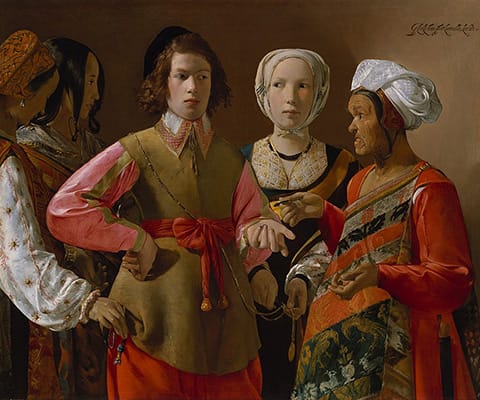
The Fortune-Teller
Art historian Deanna MacDonald writes, "This painting is full of enigmas relating to its painter, subject and provenance. Signed in Latin in its top right corner 'G. de La Tour Fecit Luneuilla Lothar' (made by G. de La Tour, Lunéville Lorraine), this is one of the few daylight paintings by an artist who specialised in nocturnal scenes". In this narrative work, a well-to-do young man looks questioningly at the toothless old woman on the far right of the canvas as she holds out a coin. While focused on whatever tale she is spinning, he fails to realize that the other women standing around him, in cahoots with the older woman who has distracted him, are in the act of picking his pockets.
MacDonald observes, "There is no indication of setting, though all wear colourful costumes. Are they in a brothel? Are the robbers gypsies? As it has a theatrical air, could it be a scene from a play, such as the parable of the prodigal son? But la Tour does not play the scene for comedy or eroticism. Sideways glances, expressive hand gestures and a mix of shadow and crisp daylight create an atmosphere ripe with tension: what will happen next? Details are meticulously rendered; from the patterns on the colourful fabrics to the words AMOR (love) and FIDES (faith) written minutely on the young man's watch chain. Despite the moralising theme, the artist seems to imbue each character with humanity: the foppish youth seems more naïve than dissolute and there is a sense of sadness and peril about the thieves (punishments for stealing in the 17th century included cutting off an ear, branding or death). The picture seems to warn of the dangers for all in a world of deceit and greed".
MacDonald also introduces an interesting historical caveat into readings of the painting. In 1984 the art historian Christopher Wright published a book in which he claimed that all of La Tour's daylight pictures were in fact forgeries. MacDonald observes, "Wright, who as a young scholar had been involved in La Tour authentications, said that he had been pressured to pronounce the work genuine by powerful figures such as Sir Anthony Blunt, the famed art expert/spy. Wright even suggested that a French restorer (who died in 1954) named Delobre who worked for Wildenstein in the USA had painted them. Many have dismissed Wright's claims, including the Met [Museum of Art] but an aura of mystery remains".
Oil on canvas - Metropolitan Museum of Art, New York, USA
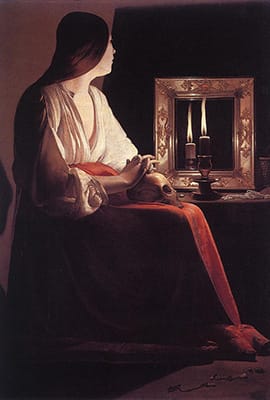
The Penitent Magdalen
The Penitent Magdalen is rich in the type of religious symbolism that would have been easily understood by audiences of La Tour's day. As the Metropolitan Museum of Art explains, "the quiet atmosphere of this painting perfectly fits the subject, Mary Magdalen, who renounced the pleasures of the flesh for a life of penance and contemplation. She is shown with a mirror, symbol of vanity; a skull, emblem of mortality; and a candle that probably references her spiritual enlightenment".
Here, as in his others works in this style, La Tour uses heightened chiaroscuro - or tenebrism - to underscore the mood and/or motivation of his subject. Conisbee writes, "At its most basic level the darkened interior enabled the artist to play on the theme of light and reflected light in contrast with the surrounding obscurity. It could set a mood conducive to contemplation and meditation, both for the actors in his pictures and for the participating spectator. Light and darkness had symbolic values on several levels: most obviously in the contrast between the spiritual darkness of our mortal world, illuminated by the light of the divine". Indeed, Mary Magdalene is a fitting subject for La Tour's Baroque treatment. The candle, which was widely interpreted as a symbol of Christ's presence, features here to connote an act of meditation and Magdalen's new faith (in Jesus) that will lead her away from a life of sin.
But perhaps the most striking stylistic feature of this work is the reflection of the candle in the mirror. As Conisbee explains, "The two flames really dominate the picture, not only because they are the source of light, illuminating the figure of the Magdalene, but also because the repeated image of the flame and its reflection are so compelling; we can see both sides of the candle, and the far side best because it is illuminated by the reflected light. Only the skull on Magdalene's lap suggests that she may be pondering the earthly reality of our mortality and the eternal truth of the spiritual life, while deciding to abandon the blandishments of the material world".
Oil on canvas - Metropolitan Museum of Art, New York, USA
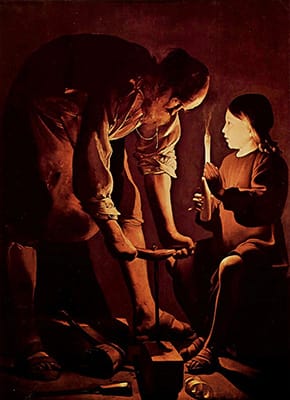
Saint Joseph in the Carpenter's Shop
A rarely depicted subject, La Tour has shown Jesus as a young boy in the workshop of his carpenter father. Joseph dominates the scene and is bent down over a piece of wood, which he is working with a tool. Jesus holds a candle to help his father to see, effectively bathing his whole face in light. Joseph's eyes seem to be turned upward towards his son, suggesting they are in conversation. In fact this could be read as a humble familial scene were it not for the painting's title.
La Tour's nocturne painting shows how he used lighting effects to elevate drama over naturalism. As authors Claudio Falcucci and Simona Rinaldi write, "one example of the extent to which what is portrayed in his paintings can be divorced from reality is visible in the Child's hand hiding the candle [...]. It is commonly known that light transmitted across a hand with its fingers closed produces a bright red colour, which is at its brightest where the fingers touch one another, and darker where the hand is thicker. In no case do we ever observe a white contour around the fingers, especially when they slightly overlap as they do in the representation. [...] Indeed, a constant element in La Tour's canvases seems to be his moving beyond the mere description of the physical phenomenon of the light released by the candle in the name of a more highly symbolic value".
Oil on canvas - Louvre Museum, Paris, France

The Choirboy
This work is characteristic of La Tour's penetrating application of the Baroque style. To enhance the drama of his scenes, and demonstrating his sophisticated handling of chiaroscuro that expresses itself in sharp tenebrism, he allowed his figures, in this case a solitary choirboy wearing a plumb colored alb with a delicately embroidered collar, to be illuminated by the light of a single candle. What is perhaps most interesting about this work from a compositional point of view is that the candle is not visible; rather it is hidden behind the hymn book that the boy holds. Only the tip of the flame and the base of the candle in the boy's hand is peeking out from behind the book. La Tour's clever composition reinforces the dedication of the boy to the task at hand while perhaps allowing the viewer to contemplate their own faith and devotion.
Art critic Laura Cumming offers this reading of the painting: "La Tour must have seen a Caravaggio somewhere, if only as a print - but nobody has ever put such emphasis on the behaviour of candlelight. The way it strokes surfaces, sends out showers of highlights, gives warmth as well as light while casting everything beyond its ambit into blackness. His figures appear spellbound by the magical flame, seized with its mystery; only the candlelight shifts. He often achieves this by hiding the light source itself. [Here a] choirboy holds a candle up to his hymns but we only see the tip of the flame above a book that's as black as night. All that is visible, in fact, in this cave of seething darkness are the fingers, the face and this mesmerising flicker, giving the queer sense of a soul in trance. And what a serene mask the boy has, radically simplified and slightly oriental like many of de La Tour's characters. His candlelight seems to sheer away irregularities like a laser, polishing skin and making diamonds of eyes".
Oil on canvas - Leicester Museum and Art Gallery, Leicester, England

The Adoration of the Shepherds
In La Tour's nativity painting, the Christ child, swaddled in white cloth, is featured bathed in light in the center of the composition. Mary sits on the left, hands clasped in prayer while Joseph, sitting directly across from her, has his hands raised in praise. Two shepherds and a peasant girl occupy the background and look down on the baby adoringly.
While the nativity has been a popular theme for artists throughout history, La Tour's approach distinguishes itself from other works in this theme. According to Conisbee, "the story lent itself to a nighttime scene, and there are countless prototypes in the sixteenth and early seventeenth centuries. La Tour has gathered a group of five sympathetically observed worshippers around the Christ Child, who seems to radiate more light than he can possibly simply reflect from the candle held by Joseph. This last detail is significant. [...] La Tour brings a sense of intimacy and tenderness to the scene, and we can admire his powers of observation in the swaddled child. [...] There is no sense of theatricality in La Tour's interpretation: no dramatic gestures or exaggerated expressions".
In this example we can see a style of rendering figures that helped distinguish La Tour from the approach of Caravaggio (to whom he was/is routinely compared). As Falcucci and Rinaldi explain, "while Caravaggio tended to emphasize the sculptural qualities of his subjects by painting them before he painted the background, which he then darkened depending on what was needed, always being sure not to let the background and the subject come into pictorial contact with each other, La Tour made very distinct borders between the background colours, which he then painted independently so that the figures were transformed into shapes applied to the background, with no dialectical rapport between the two".
Oil on canvas - Louvre Museum, Paris, France
Biography of Georges de La Tour
Childhood and Education

There is little information about the early life of Georges de La Tour, and without a surviving self-portrait (assuming he had painted one), we do not even have an image of the artist. All that is known (rumors that he was arrogant and unpopular with his neighbors notwithstanding) is that he was the second of seven children, born in Vic-sur-Seille (Vic), a large market town in the independent duchy of Lorraine (now part of north-eastern France). His father, Jean de La Tour, was a baker, his mother, also from a family of bakers, was named Sybille de Crospaux. His baptismal certificate was registered in Vic on 14 March 1593.
Early Training
That La Tour must have had an early interest in art can be assumed given that in the seventeenth century one would not have been accepted into a workshop to study unless he or she had already demonstrated a nascent talent. Art historian Gail Feigenbaum suggests that "His apprenticeship likely began around 1605, perhaps in Vic with Alphonse de Rambervilliers, a writer and amateur engraver close to the bishop of Metz, and he very likely worked in Nancy with the painter, etcher, and draftsman Jacques Bellange". Authors Claudio Falcucci and Simona Rinaldi have also conjectured that La Tour "received his artistic education in the workshop of the Swiss painter Claude Dogoz, who was working in the lively Lorraine area at the time". And while little is known about his religious upbringing, Feigenbaum observes that his devotional paintings, such as The Repentant Magdalen (c. 1640), "demonstrate powerful introspection and intense spirituality [that] may reflect the strong Catholic sentiments of Lorraine, which bordered northern Protestant states".
The influence of the Italian Baroque style, especially in the dark and dramatic backgrounds of Caravaggio (La Tour was still a teenager when the archetypal artistic rebel died, or was killed), begs the question: where would the artist have seen and studied such paintings? As Feigenbaum writes, "there has been much unresolved discussion about a possible trip to Rome". La Tour had begun painting with Dogoz and it is thought that he could have travelled to Italy with Dogoz between 1614-16, where he discovered the paintings of Caravaggio. Feigenbaum acknowledges that "La Tour's low-life subjects and his bold tenebrist manner of painting seem to be heavily indebted to the work of Caravaggio [...] and his followers in Rome [such as Bartolomeo Manfredi]. But Caravaggio's influence was spreading throughout Europe in the second decade of the century so it was by no means necessary for La Tour to have made an Italian trip". Indeed, Gerrit van Honthorst and Dirck van Baburen were working in the Baroque style in Utrecht, while in Lorraine, Jacques Bellange and Jean Leclerc were both exploring the dramatic potential for tenebrist lighting effects.
Mature Period
La Tour was married to Diane Le Nerf, a woman of status and wealth, in 1617 (La Tour gave his profession as painter on the marriage certificate). Her family were silversmiths and her father served as the minister of finance to the Duke of Lorraine. Having lived at the Le Nerf's family residence in Vic, they settled in the city of Lunéville (15 miles south of Vic) following the birth of their first child (Philipp) in 1620. (The couple were parents to a total of nine or ten children, although only three would reach adulthood, including their son, Etienne, who was officially ennobled as a painter in 1670.) In Lunéville, La Tour joined the studio of Claude Baccarat and between 1621-24 the Duke bought two of La Tour's paintings. With his reputation secured, La Tour established his own workshop in Lunéville where he employed apprentices.

The La Tours lived through a time of great uncertainty. It was the period of the Thirty Year War (1618-48) and by the 1630s Lunéville was becoming increasingly unsafe. As historian Gabriel Diss states, "La Tour needed great determination and unflinching energy not to be crushed by the incursions of armed rabble, the hordes of poverty-stricken refugees, the state of famine and the plague that struck Lorraine three times, in 1631, 1633, and 1636. He shouldered the great responsibility of supplying the needs of a workshop and a family of nine children, a burden made still greater in 1631 when he was appointed guardian of his nephews Antoine and François Nardoyen. The records show that he performed his duties with fairness and clear-sightedness".
The independent duchy of Lorraine (now northeastern France) sat between France and the Germany of the Holy Roman Empire. The citizens of Lunéville (located within the duchy of Lorraine) were trapped in the war between these two mighty colonial powers and La Tour and his family lived with a constant fear for their safety. After his home was ransacked, and his workshop razed, during a sack of Lunéville by the French in 1638, La Tour moved his family 30km to Nancy. Despite his close friendship with the Duke of Lorraine, La Tour now pledged his loyalty to the French. With his family safely settled in Nancy, La Tour left for Paris in 1639 where he took up his most prestigious position as peintre du roi ("Painter in Ordinary to King Louis XIII of France"). He made such an impression in this role that he was granted permission to set up a living space in the Louvre a year later.
Later Period
Once Lorraine became secure again (now under control of the French) La Tour was able to return home with his family. According to records dated 1643 he established a successful new studio in Lunéville. He produced religious and domestic scenes, both genres of which were popular throughout Europe. According to author Philip Conisbee, "La Tour conducted his artistic affairs in a solidly professional way: there were contracts, agreements, and schedules of payment. We know that he ran a small studio [and engaged apprentices] who helped out in the day-to-day running of his business and learned at least the rudiments of art from him. He [also] presumably trained his son Etienne".
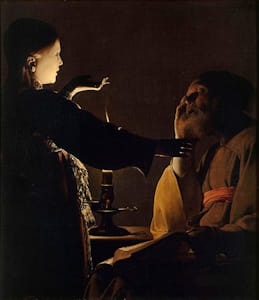
Feigenbaum writes that, "between 1644 and 1651, the marquis de La Ferté-Sénecterre [...] the French governor of Lorraine, received six of La Tour's paintings as tribute from the cities of the region". It was also during this period that his nocturne paintings became popular. Anchored in the Baroque style, it was through his nocturnes that La Tour distinguished himself among his peers in the subtle way he used light to dramatize the actions of his subjects. Historian Pat Bauer writes, "The paintings of La Tour's maturity [...] are marked by a startling geometric simplification of the human form and by the depiction of interior scenes lit only by the glare of candles or torches. His religious paintings done in this manner have a monumental simplicity and a stillness that expresses both contemplative quiet and wonder".
Tragically, the plague that swept through Europe in the 1650s ravaged Lorraine and it is believed to have been the cause of La Tour's wife's death in 1652. What wider success La Tour might have achieved will remain unknown as this epidemic, a possibly a deep sense of grief, most likely claimed the artist's life only two weeks after his wife's passing. La Tour was fifty-eight years old.
The Legacy of Georges de La Tour
According to the author Dimitri Salmon, "La Tour's works were seldom copied in engravings and hence little known, nor did he have a biographer to record his life for posterity. Finally, Lorraine was constantly devasted by war for three centuries, and with it not only the painter's workshop but also the churches, monasteries, castles and mansions where his paintings hung". It wasn't until the early twentieth century that art historians began to examine La Tour's work through a contemporary lens, beginning in 1915 through the writings of art historian Hermann Voss. Calling his art "one of the great rediscoveries of the 20th century", the historian Susan Moore states, "Today it seems inconceivable that this most compelling and singular of artists, highly successful in his day, should have been almost entirely forgotten for three centuries. [...] The reconstruction and rehabilitation of his artistic career have been described as 'the triumph of art history, and its justification'".
La Tour's work has had a profound influence on subsequent generations of artists. As Salmon states, "it is the fame of these works which is taken to task by the artists of the end of the twentieth and beginning of the twenty-first century as much as their beauty and the interest they arouse. Whatever their age, their career path or their nationality, whatever their aim or their technique, in their own way, today's artists - from the Chinese artist Yin Xin to the Mexican Alejandra Figueroa, the French artists Jérome Mesnager, Gérard Collin-Thiébaut and Frédéric Coché and the Italian Gerardo Dicrola - amply illustrate the tremendous infatuation with Georges de La Tour and the fascination that his Christ with Saint Joseph in the Carpenter's Shop and Adoration of the Shepherds exert more powerfully than ever before".
Influences and Connections

-
![Caravaggio]() Caravaggio
Caravaggio - Gerard von Honthorst
- Hendrick ter Brugghen
- Marquis de La Ferté-Sénecterre
- Duc de Lorraine
- Claude Baccarat
- Frédéric Choché
- Gerardo Dicrola
- Alejandra Figueroa
- Jérôme Mesnager
- Yin Xin
- Pierre Rosenberg
- Jacques Thuillier
- Hermann Voss
 Ask The Art Story AI
Ask The Art Story AI